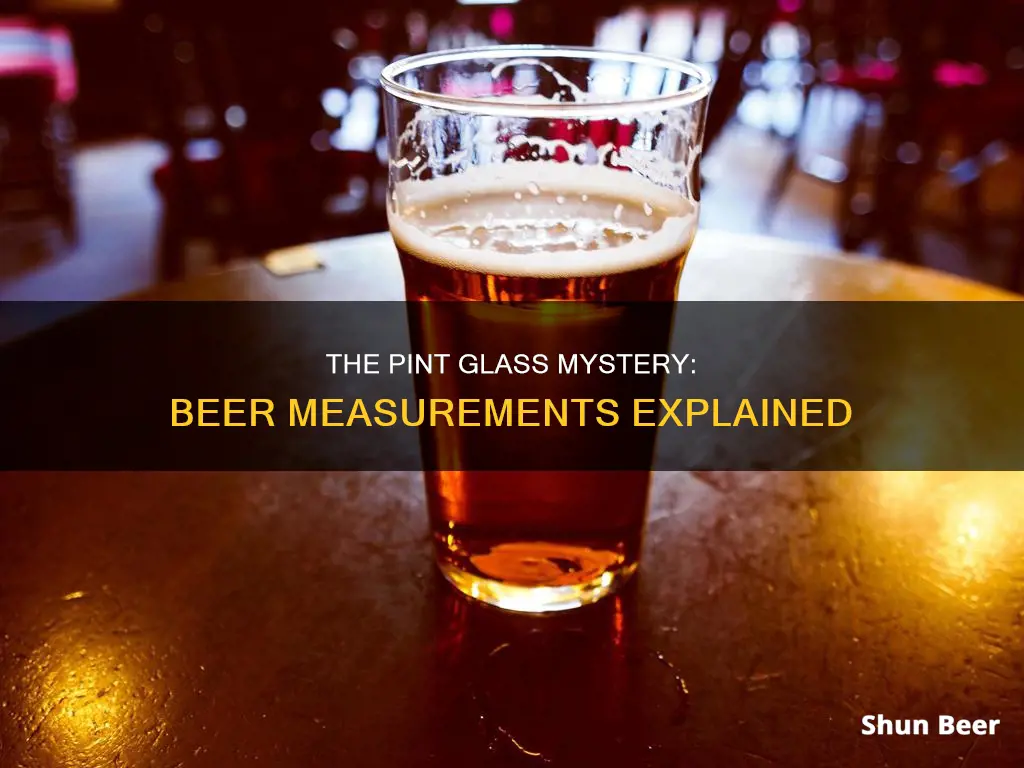
The size of a pint varies depending on where you are in the world. In the United States, a pint of beer is 16 US fluid ounces, or 473 millilitres. However, in the United Kingdom, a pint is 20 fluid ounces, or 568 millilitres. This is because the UK uses the British Imperial system, while the US uses the US Customary System.
| Characteristics | Values |
|---|---|
| Unit of measurement | Volume or capacity |
| Volume | 1/8 gallon |
| Imperial pint | 568ml |
| US liquid pint | 473ml |
| US dry pint | 551ml |
| UK fluid ounce | 28.413ml |
| US fluid ounce | 29.573ml |
| Imperial quart | 1.13 litres |
| US quart | 0.94 litres |
| Imperial gallon | 4.54 litres |
| US gallon | 3.78 litres |
What You'll Learn

The difference between a US and UK pint
A pint is a unit of volume or capacity in both the imperial and United States customary measurement systems. It is traditionally one-eighth of a gallon. However, the difference between a US and UK pint lies in the fact that they adhere to different measurement systems.
The US Pint
The US adopted the US Customary System during its formative years as a nation. In the US system, there are two types of pints: a liquid pint, which is approximately 473 mL, and a less common dry pint, which is approximately 551 mL. The liquid pint is legally defined as one-eighth of a liquid gallon, or 231 cubic inches.
The UK Pint
The UK, on the other hand, uses the Imperial System, which was established in 1824 for Great Britain and its colonies. The British Imperial pint is about 20% larger than the American pint. It is approximately 568 mL, or 20 fluid ounces, compared to the US pint's 16 fluid ounces.
Historical Context
The difference in pint sizes can be traced back to the diverse influences on measurement systems in both countries. The US Customary System was influenced not only by Anglo-Saxon, Norman, and Roman measurements but also by former colonists from Holland, France, and Spain. In contrast, the Imperial System has roots in English units, which saw a variety of influences due to the tumultuous history of the British Isles, including invasions by the Romans, Anglo-Saxons, and Normans.
So, the next time you order a pint, remember that the size may vary depending on whether you're in the US or the UK!
Beer Belly: Is Beer Fat Different to Food?
You may want to see also

The history of the pint
The pint has been a common unit of measure in Great Britain since the 14th century, though the actual volume has varied considerably over the years. In medieval times, a standard measure of beer was the equivalent of two pints, known as the London quarter.
In 1698, an Act of Parliament prescribed that ale and beer should be sold in pints, full quarts (two pints), or multiples thereof. This was to prevent pub contractors from selling their customers a shorter measure. People first drank from tankards, which were sometimes made of wood and bound with iron or leather. Following the bubonic plague, these developed into tall, one-handled, lidded mugs made from pewter, called 'steins'. The lid was used to keep the drink from becoming contaminated and to protect against plagues.
In the 18th century, a number of different gallons were recognised in Britain, including the wine gallon and the beer or ale gallon. The wine gallon was defined by Parliament in 1707 as equal to 231 cubic inches, while the beer or ale gallon was equal to 282 cubic inches.
The current imperial pint was defined by Parliament in a weights and measures act in 1824, which abolished all other gallon measures and brought in the imperial gallon, equal to the volume of 10 pounds of distilled water at a precise temperature, or 277.419 cubic inches. The imperial pint, one-eighth of this, is equal to 34.677 cubic inches or 568.261 millilitres.
In the 20th century, pint glasses became popular in the United Kingdom, replacing tankards. In the United States, a pint is 16 US fluid ounces (473 millilitres).
Explore the Difference Between Ales and Beers
You may want to see also

How many beers are in a pint?
The number of beers in a pint depends on the type of beer and the region in which the pint is being served. In the United States, a pint of beer is typically 16 fluid ounces, though some bars and restaurants may serve less than a full pint. In the United Kingdom, an imperial pint is about 20% larger than an American pint, containing 20 fluid ounces.
In the United States, the standard beer serving size is 12 fluid ounces, though servings can range from 12 to 16 ounces. A pint, therefore, contains approximately 1.33 standard beers, assuming the average alcohol by volume (ABV) is around 5%. However, it is important to note that the ABV can vary significantly depending on the type of beer. For example, a typical lager contains 4-6% ABV, while IPAs can have 7-10% ABV.
In the United Kingdom, beer must be served in either a third, half, or full imperial pint (20 ounces). Similarly, in Canada, a pint of beer must be an imperial pint (568 milliliters). In Australia, a pint of beer is 425 milliliters in South Australia and 570 milliliters in other states.
The variation in pint sizes across regions and cultures can have a significant impact on beer consumption. For instance, choosing to drink from smaller or larger containers can influence how much beer one consumes in a single sitting. Additionally, drinking additional pints may not always lead to faster intoxication, as body absorption rates vary from person to person.
Gose vs. Sour Beer: Understanding the Tart and Tangy
You may want to see also

Glassware and its impact on drinking experience
Glassware plays a significant role in the drinking experience, influencing not only the taste and aroma of the beer but also the overall consumption. The shape and size of the glass can affect how much beer is poured, the drinking rate, and the perception of the beer's volume.
Firstly, the glassware can impact the amount of beer poured. Studies have shown that people tend to pour more beer into larger glasses, and the shape of the glass can also influence the pour. For example, taller and wider glasses tend to be filled more than shorter and narrower ones, even when the capacity is the same. This may be due to a perceptual bias where people associate height with volume, leading to an overestimation of the amount poured.
Secondly, glassware can influence drinking behaviour, such as the speed of consumption. Glasses with a wider rim tend to encourage larger sips, resulting in faster drinking. In contrast, narrower glasses require more effort to tilt and extract a sip, leading to a slower drinking rate. The shape of the glass can also affect the drinking trajectory, with some shapes promoting a more decelerated pattern of consumption, characterised by a larger volume consumed in the first half of the drinking period.
Thirdly, the glassware can impact the perception of the beer's flavour, aroma, and volume. For example, the shape of the glass can influence how the beer flows when tilted, with outward-sloped glasses requiring less tilt than straight-sided glasses to pour the same volume. This can affect the size of the initial sip, with outward-sloped glasses potentially leading to larger initial gulps. Additionally, the shape and size of the glass can impact the perception of volume, with taller glasses often perceived to hold more liquid, even when the width is smaller. This "elongation effect" may be due to people focusing on one dimension, such as height, and failing to fully adjust for the width.
Finally, the glassware can enhance the beer's head, which is important for retaining the aroma. Glasses with a wider top help maintain the head, capturing the aroma and enhancing the flavour profile.
In conclusion, the choice of glassware can significantly impact the drinking experience. From altering consumption rates and amounts poured to enhancing flavour and aroma, the right glassware can elevate the overall enjoyment of the beer.
Beers Across America: A Diverse and Delicious Journey
You may want to see also

How to estimate alcohol consumption
A pint of beer is 568ml. The number of units of alcohol in a pint of beer depends on the alcoholic content, which is measured by alcohol by volume (ABV).
In the UK, one unit of alcohol is equal to 10ml or 8g of pure alcohol, which is the amount an average adult can process in an hour. In the US, a "standard drink" contains 14 grams of alcohol.
To estimate alcohol consumption, it is useful to know how many units of alcohol are in each drink. For example, a pint of standard-strength lager or ale with a 4.5% ABV contains 2.5 units of alcohol. A pint of lower-strength lager with a 3.6% ABV contains just over 2 units of alcohol, while a pint of higher-strength lager with a 5.2% ABV contains 3 units.
Using the formula:
> strength (ABV) x volume (ml) ÷ 1,000 = units
We can calculate the number of units in a pint of beer with a 4% ABV as follows:
4 (ABV%) x 568 (ml) ÷ 1,000 = 2.3 units
It is important to note that the effects of alcohol on health are not fully understood, and while some studies suggest potential health benefits, these are relatively small compared to the risks. Heavy drinking can lead to serious health issues, and driving while intoxicated can have severe consequences. To maintain a balanced lifestyle, it is important to keep track of your alcohol consumption and understand the risks associated with excessive drinking.
Beer Nuts vs Deer Nuts: A Nutty Joke Explained
You may want to see also
Frequently asked questions
It depends on where you are. In the US, a pint of beer is 16 fl oz (473ml). In the UK, a pint is 20 fl oz (568ml).
The US and the UK use different measurement systems. The US uses the US Customary System, while the UK uses the Imperial System.
Yes, other countries may use different measurements for pints. For example, in Australia, a pint is 474ml, but in South Australia, it's 568ml. In Canada, a pint is the same as in the UK (568ml), but in Quebec, a "pinte de bière" legally refers to an imperial quart (1136ml).







